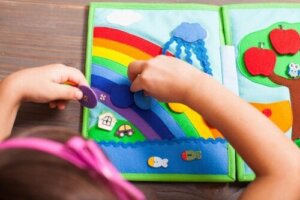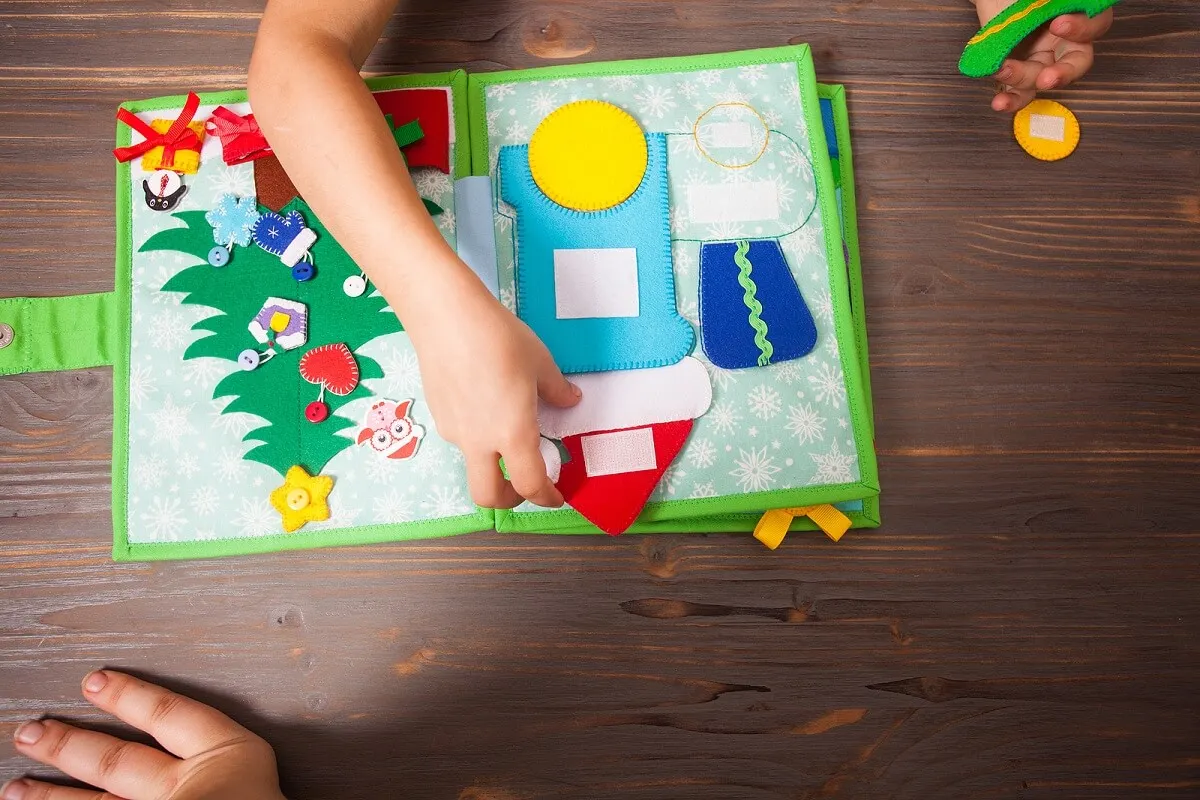Sensory Books for Babies: Features and Benefits

Books are a major part of childhood; they accompany us in those precious family moments before bedtime and transport children to fantastic and imaginary worlds. However, you don’t have to wait for your little ones to learn to read before they can enjoy the benefits of books. If your baby is at least six months old, sensory books for babies can become one of their favorite things.
These books are smaller than usual and are made of a variety of materials such as cardboard, felt, or EVA foam. In addition to pictures and text, they feature textures, sounds, lights, and other sensory games that stimulate the baby’s senses and learning. Would you like to find out more about their benefits? Read on!
What are sensory books for babies?
The senses allow babies to explore and learn about the environment around them. Through the stimuli and information they receive, they can learn, discover and begin to get along in their environment. Therefore, sensory books for babies are an excellent pedagogical tool.
Also called “quiet books” or “soft books”, they’re essential items for every home with infants. They’re available in various forms, for example:
- Bath books that your little one can use in the bathtub
- Song books
- Books that allow them to explore different textures.
- Books with manipulative elements such as Velcro or buttons.
This type of book is inspired by the Montessori philosophy and aims to promote learning and the development of basic skills in children. To do this, they provide sensory experiences adapted to the infant’s age, capable of arousing their attention and curiosity.

Find out more here: 10 Exercises to Stimulate Your Baby’s Gross Motor Skills
The benefits of a sensory book for babies
This type of book provides a number of benefits to child development. Although it’s common to find them in most homes, many aren’t aware of their vast potential. Because of this, we’ll show you some of their main advantages.
They stimulate the development of the senses
These books offer a varied and appropriate stimulation to the child’s age. In this way, they help to regulate their attention and to tolerate stimuli. This can be very useful for children with difficulties such as autism spectrum disorder (ASD) or attention deficit hyperactivity disorder (ADHD) who are hypo or hypersensitive to stimulation.
They promote fine motor skills and hand-eye coordination
By using the book and manipulating the interactive elements, the child develops manual skills, practices coordination, and motor skills, and improves muscular and skeletal movements.
They boost curiosity and creativity
Thanks to the scenes, characters, and texts, they attract the attention of the little ones and stimulate their imagination and creativity.
They help to exercise memory and understanding of concepts
Children learn to relate words with objects, textures, sounds, and images, which has a positive effect on their memory. In addition, it facilitates the understanding of concepts, as they can experience them for themselves.
You might be interested in: Tips for Stimulating a Baby’s Visual Capacity
They help in the acquisition of language and literacy
Sensory books for babies and infants help the child to expand their vocabulary and to become familiar with letters and sounds.
They promote the recognition of colors, shapes, and sizes
By working with several senses, they promote the learning of notions such as shapes, contours, colors, and sizes. Children can touch and interact with the elements in the book, instead of simply observing them.

They encourage scientific thinking and problem solving
They’re an excellent tool for children to explore and discover at their own pace. In this way, they can generate hypotheses and test them on their own. This develops their scientific and problem-solving skills. Even other skills are stimulated, such as the acquisition of mental schemes and the understanding of logical-mathematical concepts.
What should you take into account when choosing a sensory book?
As we’ve mentioned, there are many sensory books on the market, but you can also choose to make them at home. However, you have to ensure that they meet the following requirements:
- A small and manageable size for the child, according to their age.
- Thick pages and resistant materials that allow them to be handled without risk.
- Eye-catching illustrations and an attractive appearance. Pastel colors may be more suitable than intense colors for certain children who are overwhelmed by excessive stimulation.
- They should have different shapes, textures, and elements that stimulate the senses, such as hearing, touch, sight, or even smell.
- It’s important for them to have interactive elements to help the child explore and learn. For example, rubber balls to squash, papers that rattle when crumpled, Velcro, zippers, buttons, or poppers.
- Vivid pictures, simple text, and basic storylines that are easy for children to follow.
- They should be adapted to the age of the child. For example, babies may enjoy squishing colored paper, while preschoolers can learn the different tones of a musical instrument by pressing the keys.
Sensory books: a natural alternative in a technological world
For several years now, technological devices have been occupying a relevant place when it comes to entertaining and educating babies and infants. However, simpler alternatives, made with natural materials and designed for the child to be an active agent in their own learning, are a very positive tool.
This is the case with sensory books, playful, didactic, and versatile elements that can capture a child’s attention, while promoting their development at different levels. Opting for this type of toy is a good way of accompanying their growth and respecting their needs and stages.
In general, it encourages a type of stimulation that becomes their main way of learning. We encourage you to try them and even make your own.
All cited sources were thoroughly reviewed by our team to ensure their quality, reliability, currency, and validity. The bibliography of this article was considered reliable and of academic or scientific accuracy.
- Pauta Yanza, M., & Perazzo, D. (2020). QUIET BOOK: AULA SENSORIAL DIGITAL. Convergence Tech, 4(IV), 36–48. https://doi.org/10.53592/convtech.v4iIV.33
- Escanta, M. (2016) Desarrollar las relaciones lógico matemáticas en niños y niñas de 5 años de edad mediante la utilización de Quiet Books. Manual instructivo y de actividades dirigido a docentes del Centro de Desarrollo Infantil “Portal de Belén» del Distrito Metropolitano de Quito, periodo académico 2016. (Bachelor Thesis)
- Ramírez Cueva, I., & Susanibar Escobar, L. M. (2021). Los libros sensoriales inspirados en el método Montessori para favorecer el desarrollo de las habilidades manuales en los niños del jardín 384 rosa de américa–Valdivia en Santa María. (Bachelor Thesis)
This text is provided for informational purposes only and does not replace consultation with a professional. If in doubt, consult your specialist.









